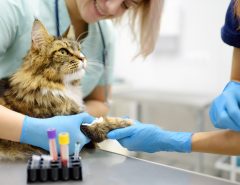Hyperthyroidism is a health issue where pets’ thyroid glands overproduce hormones, leading to symptoms like weight loss, hyperactivity, increased appetite, and coat changes. Common in cats, especially older ones, it can cause serious health problems if untreated. As pet owners, knowing its signs is vital so we can seek veterinary help. Early detection ensures proper management, including medication or dietary adjustments, helping maintain our pets’ health and happiness. Always watch for unusual behavior in pets and consult your vet for guidance and treatment options.
What Hyperthyroidism Means for Your Pet
When a pet has hyperthyroidism, they often lose weight despite having an increased appetite. They may also show signs of restlessness, faster heart rate, and more energy, although this energy seems to be nervous rather than healthy vitality. Other common symptoms include vomiting, diarrhea, increased thirst and urination, and a coat that looks unkempt. This condition typically occurs in middle-aged to older cats and is rare in dogs. Not treated can lead to severe complications affecting the heart and other organs.
Signs and Symptoms of Hyperthyroidism in Pets
Hyperthyroidism is a common condition in pets, particularly middle-aged and older cats. The following vital signs and symptoms can indicate that your pet might be suffering from this hormonal imbalance:
-
Weight Loss: Despite increased appetite, your pet may lose weight.
-
Excessive Thirst and Urination: You might notice your pet drinking more and needing to urinate more frequently.
-
Hyperactivity: Look for signs of restless behavior or an inability to settle down.
-
Gastrointestinal Issues: Symptoms can include vomiting or diarrhea.
-
Increased Heart Rate: A heart that beats rapidly can indicate hyperthyroidism.
-
Poor Coat Condition: Your pet’s fur may appear unkempt or greasy.
These symptoms should not be ignored. If you notice them, a trip to your veterinarian for a proper diagnosis is crucial. Remember, every pet is different, so the severity and combination of these symptoms can vary.
Vet Diagnostics
Diagnosing hyperthyroidism usually involves a physical examination and blood tests that measure the thyroid hormone levels in your pet’s blood. Some cases might also require imaging tests. This is where a vet diagnostic lab can play a pivotal role. The dedicated professionals at these labs use their expertise and advanced equipment to help pinpoint your pet’s health issues with accuracy.
Treatments and Management of Hyperthyroidism
Treatment options for hyperthyroidism in pets vary and may include medication, surgery, or dietary changes. Another common approach is radioactive iodine therapy, which is highly effective but requires specialized care. Additionally, ongoing treatment might be necessary to keep the condition under control. For cats, options like cat hyperthyroidism treatment are explicitly tailored to feline physiology, ensuring the best possible outcome.
Impact on Quality of Life
Hyperthyroidism, if left untreated, can have a profound impact on a pet’s quality of life. It’s essential to be aware of the risks and to manage the condition effectively. Here’s what you should know:
-
Deteriorating Health: Without treatment, pets can develop severe complications that affect overall well-being.
-
Risk of Hypertension: Hyperthyroid pets face an increased risk of high blood pressure, leading to further health complications.
-
Heart Disease: The strain on the heart might lead to cardiac conditions, severely compromising your pet’s health.
-
Therapeutic Management: With the right treatment plan, pets can lead a normal and active lifestyle.
-
Regular Vet Visits: Consistent check-ups are critical to monitor your pet’s health status and adjust treatment as necessary.
-
Attentive Care: Observing your pet’s behavior and physical state changes can ensure quick intervention.
Overall, staying vigilant and providing ongoing care is vital to helping your hyperthyroid pet maintain a joyful and energetic life.
Prevention Strategies for Hyperthyroidism in Pets
Maintaining your pet’s health is crucial, and while you can’t completely prevent hyperthyroidism, you can take steps to reduce the risk. Here are essential strategies:
-
Balanced Diet: Provide a nutritious, well-balanced diet. Avoid excessive iodine as it can contribute to thyroid problems.
-
Regular Vet Visits: Keep up with routine veterinary check-ups. Early detection of thyroid issues can lead to more effective management.
-
Monitor Health: Stay vigilant for signs of thyroid imbalance, including weight loss, excessive hunger, or restlessness, and consult your vet if symptoms arise.
For pets that need more detailed imaging to assess the impact of hyperthyroidism, options such as a vet ct scan Springfield, VA, can provide a three-dimensional view of your pet’s internal structures. This enhanced view can help in creating a comprehensive treatment plan.
Final Thoughts
Hyperthyroidism is a condition that can greatly affect our pet’s health, but it doesn’t have to be a verdict. With advancements in veterinary medicine, we can tackle this issue in numerous ways. Proactive monitoring, regular vet visits, and timely interventions can manage hyperthyroidism effectively, allowing our pets to live entire and vibrant lives. So keep an eye on your furry friends, stay connected with your vet, and know that even if hyperthyroidism comes knocking, plenty of resources are available to take control and ensure your pet’s happiness and well-being.




